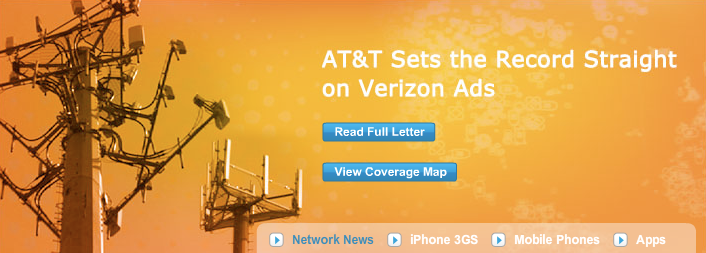AT&T responds to 'false and misleading' Verizon ads
"As the U.S. market leader in wireless data service, we typically don't respond to competitors' advertising," AT&T began its letter, entitled 'AT&T sets the Record Straight on Verizon Ads.' "However, some recent ads from Verizon are so blatantly false and misleading, that we want to set the record straight about AT&T's wireless data coverage."
It goes on to explain that AT&T's wireless data network reaches nearly all of the U.S. population, and details the differences between 3G, EDGE and GPRS data connections.
It's another example of AT&T becoming proactive, and stepping up its efforts to portray its network in a positive light in the face of Verizon's attacks.
The letter follows Thursday's news that AT&T has amended its federal complaint against competitor Verizon Wireless, seeking a restraining order against holiday season ads that have attacked its network and described the iPhone as "misfit" because of poor 3G coverage. Previously, AT&T had filed a complaint against other Verizon ads that criticized its network, using the tagline "There's a map for that."
AT&T has argued, as it did again in its newly published letter, that Verizon's advertisements are misleading, suggesting to users with maps of coverage that blank areas represent no signal whatsoever. Verizon's maps demonstrating 3G coverage show its own U.S. map with ubiquitous coverage, while AT&T's service is portrayed as much smaller.
In response to the latest "Island of Misfit Toys" advertisement, AT&T told a federal court that "the image of the sad and wilting iPhone on an island of misfit toys falsely communicates that the iPhone is a broken device because it cannot browse the Web or download applications when outside of AT&T's depicted coverage area."
AT&T's letter to its customers in response to the Verizon ads follows in its entirety:
- To Our Customers:
As the U.S. market leader in wireless data service, we typically don't respond to competitors' advertising. However, some recent ads from Verizon are so blatantly false and misleading, that we want to set the record straight about AT&T's wireless data coverage.
The key facts are:
- AT&T's wireless data coverage reaches 303 million people – or 97% of the U.S. population, where they live and work. Our data coverage consists of 3 different types of technology:
- 3G. 233 million people or 75% of the population are covered by AT&T's 3G network, the nation's fastest.
- EDGE. 301 million people or more than 96% of the population are covered by EDGE.
- With both 3G and EDGE coverage, customers can access the Internet, send e-mail, surf the Web, stream music, download videos, send photos, text, talk and more. The only difference – with some data applications, 3G is faster than EDGE
AT&T is the #1 network for smartphones, with twice the number of smartphone customers than Verizon, our closest competitor. Some of the reasons include:
Most popular smartphones. Unlike Verizon, AT&T offers the most popular smartphones in the industry.
More wireless apps. Unlike Verizon, AT&T customers have access to more than 100,000 applications, more than with any other wireless company.
Talk and E-mail at the same time. Unlike Verizon, AT&T's 3G network lets wireless customers simultaneously talk and surf the web or do e-mail.
Fastest 3G in the nation. Unlike Verizon, AT&T has the nation's fastest 3G network.
Thank you for allowing us to set the record straight. We appreciate your business and will continue to work hard to deliver the best wireless data experience in the industry.
Your AT&T Team
 Sam Oliver
Sam Oliver











 Malcolm Owen
Malcolm Owen
 William Gallagher and Mike Wuerthele
William Gallagher and Mike Wuerthele
 Christine McKee
Christine McKee
 William Gallagher
William Gallagher

 Marko Zivkovic
Marko Zivkovic









